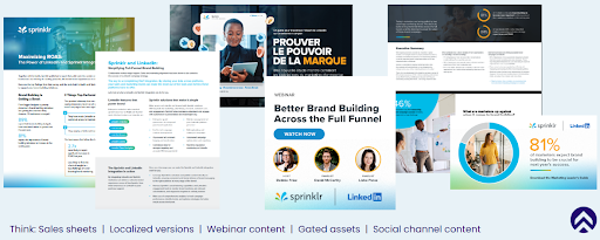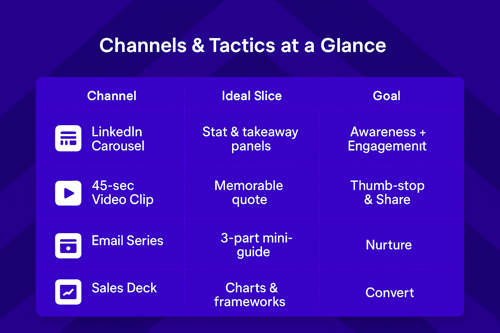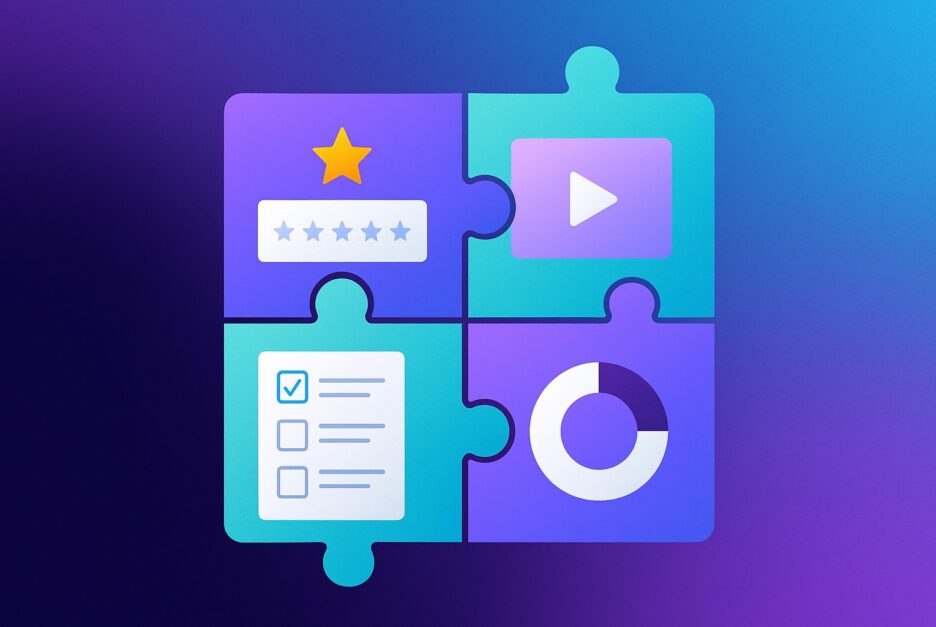It happens all too often: a B2B marketing team works hard on a great report, video or blog post, gets it launched to great fanfare, shares it once or twice, and then … it quietly disappears.
Great content takes real effort — strategy, time AND budget — so it should work harder for you than just that one moment in the spotlight. Repurposing is one of the most effective ways to make the most of what you’ve already built. And in a world where every content team is asked to do more with less, strategic repurposing of content is one of the smartest moves you can make to ensure that your content investments are paying off.
In this post, we’ll share how our B2B marketing agency approaches repurposing as part of content strategy from day one to make your content investment works harder and is more relevant for specific audiences. Of course this isn’t just theory – we’ll also share practical examples of how this philosophy plays out in the real world.
Let’s dig in.
Why repurposing content makes sense
In many cases, marketing content drives a wave of engagement and impact when it gets published and initially promoted, then it disappears into the ether. That’s not because it wasn’t valuable — it’s often because there simply wasn’t a plan to carry it further. Our CEO Lee Odden has referred to this marketing malady as “invisible content syndrome“.
When you put time, effort, and budget into a strong piece of content, it deserves more than a one-time push. Repurposing helps extend its value across platforms, formats, and audiences, giving you more impact without having to start from scratch every time.
Marketing teams everywhere are asked to do more with less. Repurposing flips that pressure into opportunity by:
- Multiplying ROI: If your content performed well once, there’s a good chance it can work again in a new format. Repurposing gives you more return on the investment you’ve already made.
- Reducing guesswork: When you build on something that already works, you can focus on refining, not reinventing.
- Widening reach: Not everyone wants to read a 2,000-word article. But that same insight might land perfectly as a LinkedIn carousel, a short video, or a few slides in a sales deck. Repurposing helps you deliver the same insight in the format each audience prefers.
This is a strategy for maximizing use and effectiveness of content that we lean on every day at TopRank Marketing, and it’s one of the first things we bring up with clients. Because when repurposing is baked into the plan, what would have been a one-time deliverable becomes a long-term asset.
Five steps for day‑one content repurposing strategy
The real impact of repurposing comes when you think about it from the very beginning. Integrated as part of your content strategy, you can build pieces that are designed to stretch, adapt and stay relevant.
Here’s a five step framework on how to make that happen:
- Start with a “Hero” Asset – Robust reports, research or documentaries give you enough depth to slice, dice and remix without losing substance.
- Design Modular Content Blocks – Write and film in self‑contained sections—stat boxes, quote pulls, mini‑stories—so they lift cleanly into other formats.
- Plan Format Cascades Early – Before draft #1, map how the core asset will cascade into social clips, email nurture, sales decks, etc.
- Capture More Than You Need – Record behind‑the‑scenes, extra B‑roll, alternative quotes. These “offcuts” become social gold later.
- Tag Metrics to Each Child Asset – Know what success looks like for every spin‑off piece so you can double‑down or retire, fast.
When clients engage us we’ll use a guideline like the above framework to deliver the maximum return on the investment. For this post, I’ll walk through how these steps come together along with some content repurposing examples.
Hero First: Start with a robust core asset
The best repurposing eforts start with something substantial. That doesn’t mean it has to be extremely long, but it should have depth, perspective, and enough meat to be reshaped into other formats without losing its meaning.
Think in terms of high-value building blocks:
- A research report can fuel blog posts, infographics, social posts, slides and even webinars.
- Webinars or interviews can become short video clips, written recaps, quote graphics, or podcast content.
- Case studies can turn into tip-based email sequences, social content, or videos.
Real world content repurposing examples:
A video is worth thousands of words: When we partnered with Sprinklr on the award-winning Socialverse campaign, the hero asset was a documentary-style video masterclass. But we didn’t stop there. That one asset spun out into blog content, short-form social clips, a blooper reel, and more — each version tailored for different platforms and audiences.
Research Reports are a goldmine for repurposing: Proving the Power of Brand: A Guide to Maximizing the Full-Funnel Impact of LinkedIn. We partnered with Sprinklr and LinkedIn on this co-branded research report that unpacked how enterprise marketers are building strong, resilient brands. But we didn’t stop at the PDF. That one report was spun out into localized versions, sales sheets for different personas, gated assets for lead generation, webinar content, and a steady drumbeat of social posts that kept the conversation going.
That single report was turned into a full campaign with staying power — built to reach people in different roles, regions, and stages of the funnel.

Need to Make the Most of Your Content?
Chances are, you already have content that could do the same. Maybe it’s a report that had a strong launch and then stalled. Maybe it’s a great webinar that’s been sitting in the archives. Or even a dated ebook that could be revamped and updated for renewed relevance. The key is recognizing what’s still useful and reshaping it for today’s needs.
Plan for modularity: Ideate and build for repurposing from day one
Most clients don’t come in saying, “Let’s slice this up a hundred ways” — but we do. That’s part of the full-service value: we help you see the potential you didn’t know you had.
When repurposing is built into the content plan from the start, every asset is created with flexibility in mind. That means thinking beyond the initial format and asking: Where else can this live? How else can this story be told? What would make it easier to adapt across channels later on?
Here’s how we approach it:
- Map your formats early. Before the first draft even begins, outline a few key places where the content might go next. A blog post that could lead to a short video? A report that naturally breaks into a three-part email campaign? Document these from the start.
- Capture assets along the way. Running a webinar? Record the behind-the-scenes. Interviewing an expert? Get a few extra quotes or video takes. These little moments become gold later when you need quick-turn content with added value.
- Write with modularity in mind. When sections are self-contained and focused on one point at a time, they’re easier to pull into social posts, newsletters or slides.
This kind of thinking saves time later, and it shapes better content upfront. Because when you plan for repurposing, you’re already thinking about how to make your message resonate across formats, audiences and attention spans.
Adapt the message for each format and channel
“Adapting content for various platforms is ranked as the #1 challenge creative professionals face when repurposing content.” Source: Canto and Ascend2
Once you have a strong core asset — like a research report, longform article, or webinar — you can start to break it down. But instead of just slicing it up, tailor the message for where it’s going and who it’s for.
Here’s how this “repurposing on purpose” plays out:
- LinkedIn carousels: Pull out key stats, insights or takeaways and turn them into scrollable, visual slides. Think snackable, high-impact ideas that spark conversation.
- Video snippets: Grab the most compelling quote, story, or data point from a longer video or webinar and package it into a short clip, perfect for social.
- Email sequences: Break content into a short series of emails that build on each other. Useful for guides, how-to content or research with layered insights.
- Slide decks: Pull charts, frameworks or key points into slides that support sales conversations, internal alignment or event presentations.

Just as important as the format is adapting the depth and tone for the audience. A CEO might want a sharp stat and a bottom-line takeaway, while a practitioner is more likely to look for context and actionable next steps (hi, practitioners!). Similarly, a blog post gives you space to go deeper and explain the “why,” but a social post needs to hook fast and deliver value in a flash.
Same idea, different lens. That’s the power of thoughtful repurposing: it ensures your message resonates, no matter where or how people find it.
Get Started with Your Day One Plan
Round-up of B2B content repurposing best practices:
Let performance shape your plan.
Keep an eye on what’s working. Metrics like engagement, clicks and conversions help you decide what to expand, reshape or retire. The more you learn, the sharper your strategy becomes.
Don’t forget the SEO boost.
Repurposed content checks a lot of SEO boxes: it expands your keyword footprint, strengthens internal linking, and refreshes your site in the eyes of search engines.
Let AI lend a hand.
Generative AI is not very good at creating original or unique content, but it’s great at taking your original, unique content and spinning it in different ways. Play around with asking ChatGPT to tailor your piece for different formats or audiences.
Make it easy to reuse.
Build with flexibility in mind. Create core assets that can easily spin into multiple formats and keep source files organized so your team can work faster.
Aim for variety, not repetition.
Change up the format, tone or depth for each channel and audience. Repurposing isn’t copying; it’s reimagining with purpose.
Plan to repurpose from day one.
The best repurposing happens when it’s baked into the strategy—not tacked on later. Think ahead, and you’ll get more mileage with less lift.
“Repurposing isn’t copying; it’s reimagining with purpose.”
Build smarter, not harder
You don’t always need more content – but you need more from your content.
So the next time someone calls for a brand-new campaign, pause and ask: What do we already have that’s worth another look? What insight is still relevant and ready for a second life?
Connect with us to build your own content repurposing strategy.



